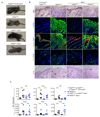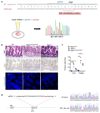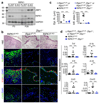RIPK1 counteracts ZBP1-mediated necroptosis to inhibit inflammation
- PMID: 27819681
- PMCID: PMC5755685
- DOI: 10.1038/nature20558
RIPK1 counteracts ZBP1-mediated necroptosis to inhibit inflammation
Abstract
Receptor-interacting protein kinase 1 (RIPK1) regulates cell death and inflammation through kinase-dependent and -independent functions. RIPK1 kinase activity induces caspase-8-dependent apoptosis and RIPK3 and mixed lineage kinase like (MLKL)-dependent necroptosis. In addition, RIPK1 inhibits apoptosis and necroptosis through kinase-independent functions, which are important for late embryonic development and the prevention of inflammation in epithelial barriers. The mechanism by which RIPK1 counteracts RIPK3-MLKL-mediated necroptosis has remained unknown. Here we show that RIPK1 prevents skin inflammation by inhibiting activation of RIPK3-MLKL-dependent necroptosis mediated by Z-DNA binding protein 1 (ZBP1, also known as DAI or DLM1). ZBP1 deficiency inhibited keratinocyte necroptosis and skin inflammation in mice with epidermis-specific RIPK1 knockout. Moreover, mutation of the conserved RIP homotypic interaction motif (RHIM) of endogenous mouse RIPK1 (RIPK1mRHIM) caused perinatal lethality that was prevented by RIPK3, MLKL or ZBP1 deficiency. Furthermore, mice expressing only RIPK1mRHIM in keratinocytes developed skin inflammation that was abrogated by MLKL or ZBP1 deficiency. Mechanistically, ZBP1 interacted strongly with phosphorylated RIPK3 in cells expressing RIPK1mRHIM, suggesting that the RIPK1 RHIM prevents ZBP1 from binding and activating RIPK3. Collectively, these results show that RIPK1 prevents perinatal death as well as skin inflammation in adult mice by inhibiting ZBP1-induced necroptosis. Furthermore, these findings identify ZBP1 as a critical mediator of inflammation beyond its previously known role in antiviral defence and suggest that ZBP1 might be implicated in the pathogenesis of necroptosis-associated inflammatory diseases.
Conflict of interest statement
The authors declare no competing financial interest.
Figures










References
Publication types
MeSH terms
Substances
Grants and funding
LinkOut - more resources
Full Text Sources
Other Literature Sources
Molecular Biology Databases
Research Materials
Miscellaneous

